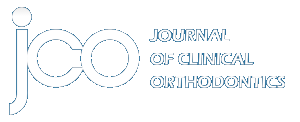2002 JCO Study of Orthodontic Diagnosis and Treatment Procedures, Part 1: Results and Trends
The next several issues of JCO will present the results of the fourth JCO Study of Orthodontic Diagnosis and Treatment Procedures, previously conducted in 1986, 1990, and 1996. This month's article covers the basic results and compares them to those of past studies; future articles will break down the 2002 data into various categories.
Methodology
The 1996 Treatment Study questionnaire was revised based on past responses and on suggestions from JCO editors and orthodontic manufacturers regarding the latest materials and techniques. It was mailed on June 26, 2002, to 8,812 orthodontists, which represented virtually all the specialty practitioners in the United States. Of these, 789 questionnaires were returned, for a response rate of 9.0%. The size of the response and the consistency of answers and demographic data with previous JCO studies indicate to us that the results are valid.
The questionnaire responses were entered on computer by an independent company and analyzed with the Statistical Package for the Social Sciences. A few specific responses that were obviously erroneous or out of range were excluded from calculations of those particular tables.
In this Study, the median, which is the middle number when all responses are ranked from highest to lowest, is often reported instead of the mean, which is the arithmetical average, because medians are less affected by extremely high or low responses. Means must be used when breaking down responses by category, as will be done later in this series of articles.
"NA" in a table indicates that a particular item was not included in that year's questionnaire. In many cases, respondents were asked to indicate whether they used a technique or appliance "occasionally" or "routinely". To make comparisons among the four studies easier to read, the "occasionally" responses have been omitted from this article.
Similar articles from the archive:
- 1996 JCO Study of Orthodontic Diagnosis and Treatment Procedures, Part 1: Results and Trends November 1996
- 1990 JCO Study of Orthodontic Diagnosis and Treatment Procedures, Part 1: Results and Trends March 1991
- 1986 JCO Study of Orthodontic Diagnosis and Treatment Procedures Part 1 - Overall Results September 1986
Demographics
The current Study agreed with the JCO Orthodontic Practice Studies in showing a gradual aging of the orthodontic population and an increase in female practitioners (Table 1). Gross income and numbers of active cases continued to increase, while the percentages of adult patients and two-phase patients remained constant at 20% each. About 6% of the respondents were affiliated with management service organizations.
Although the median age of the youngest patient stayed at 6, the median age of the oldest patient increased from 60 to 63, and the median age normally recommended to begin treatment rose from 10 to 11. The most common appointment interval increased from four weeks in 1996 to six weeks in 2002.
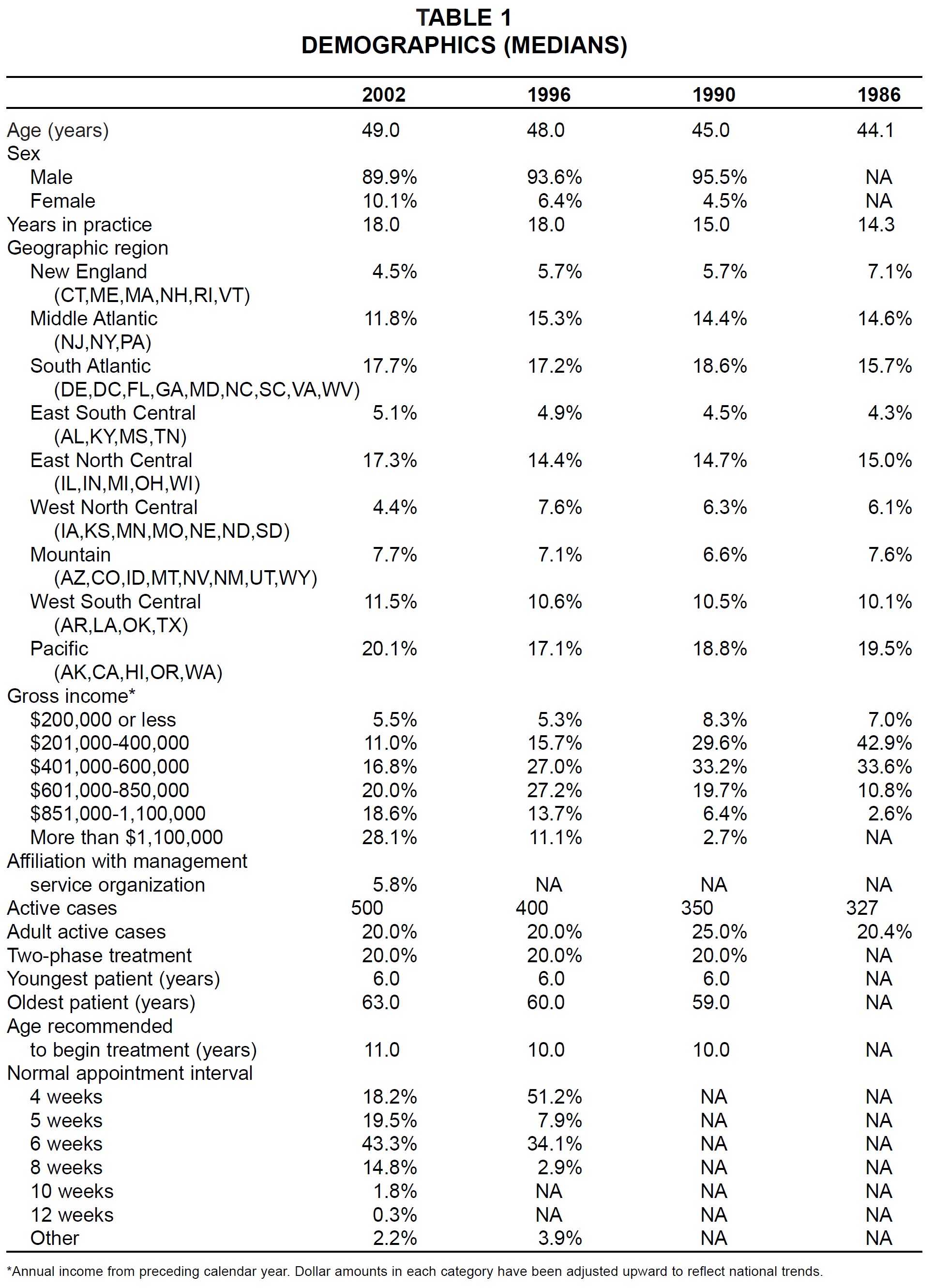
Diagnostic Records
Of the diagnostic records surveyed, most continued a gradual decline in routine usage since the 1986 Study, the only notable exceptions being panoramic x-rays and digital records (Table 2). About two-thirds of the respondents mounted casts in centric occlusion rather than in centric relation. The percentages that reported routinely mounting casts on articulators were about the same as in 1996, but fewer orthodontists routinely used bite registrations than in 1996. Nearly two-thirds of the clinicians used digital cameras routinely for pretreatment photographs in 2002, while more than half used them routinely for post-treatment photos. Digital photography was too new to be included on the questionnaire six years ago.
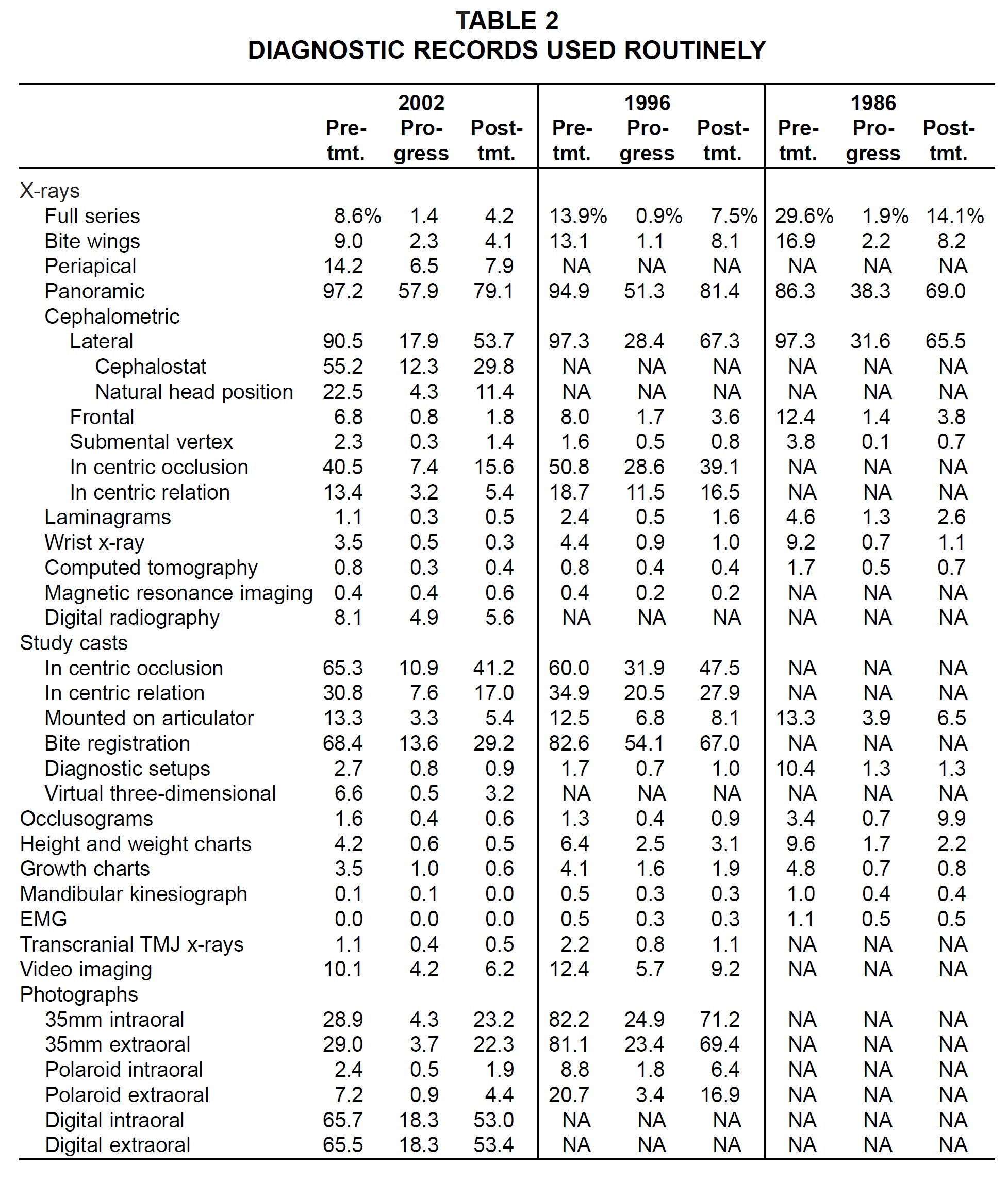
Slightly fewer respondents performed routine cephalometric analyses than in past studies, but the percentages who routinely used computerized tracings or analysis increased (Table 3). The relative popularity of particular analyses has stayed about the same since 1986, although none increased in routine usage between 1996 and 2002. The most commonly used analyses remained the Steiner, Ricketts, Tweed, Wits, Downs, and McNamara, in that order, while sizable numbers of respondents used "eyeball" or personalized analyses.
Routine use of archform analyses also continued to decline gradually, although slightly higher percentages used the Brader and Bonwill-Hawley analyses routinely in 2002 than in 1996. Customized systems were used most often, followed by the Roth analysis, the clinician's own analysis, the Bolton Index, and the Tweed arch-length analysis.
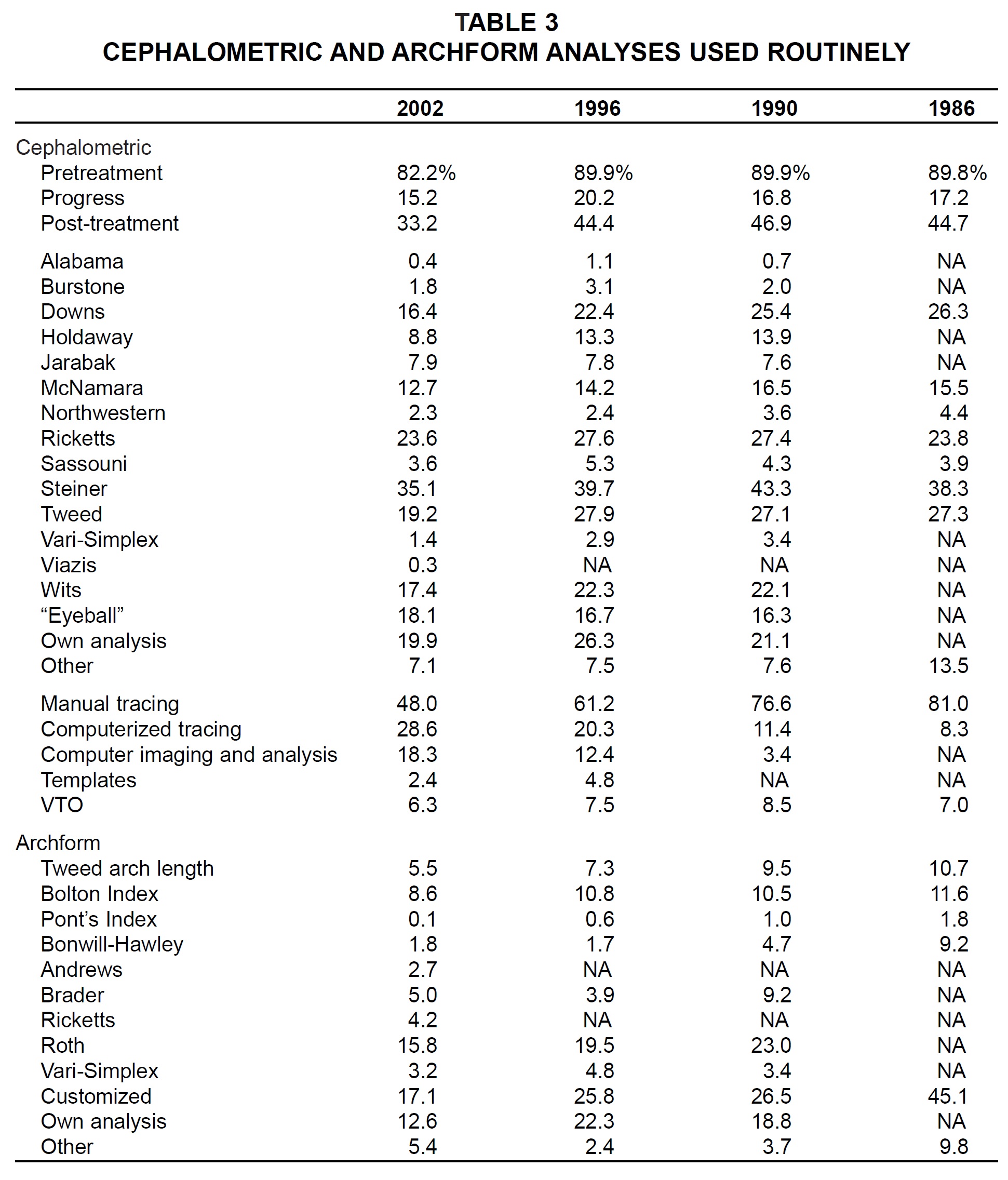
Fixed Appliances
As in past studies, preadjusted fixed appliances were used routinely by a majority of respondents, although standard edgewise systems showed a substantial rise in usage (Table 4). The Roth prescription was by far the most common. Higher percentages of clinicians used Hyrax palatal expanders and transpalatal arches routinely in 2002 compared to 1996.
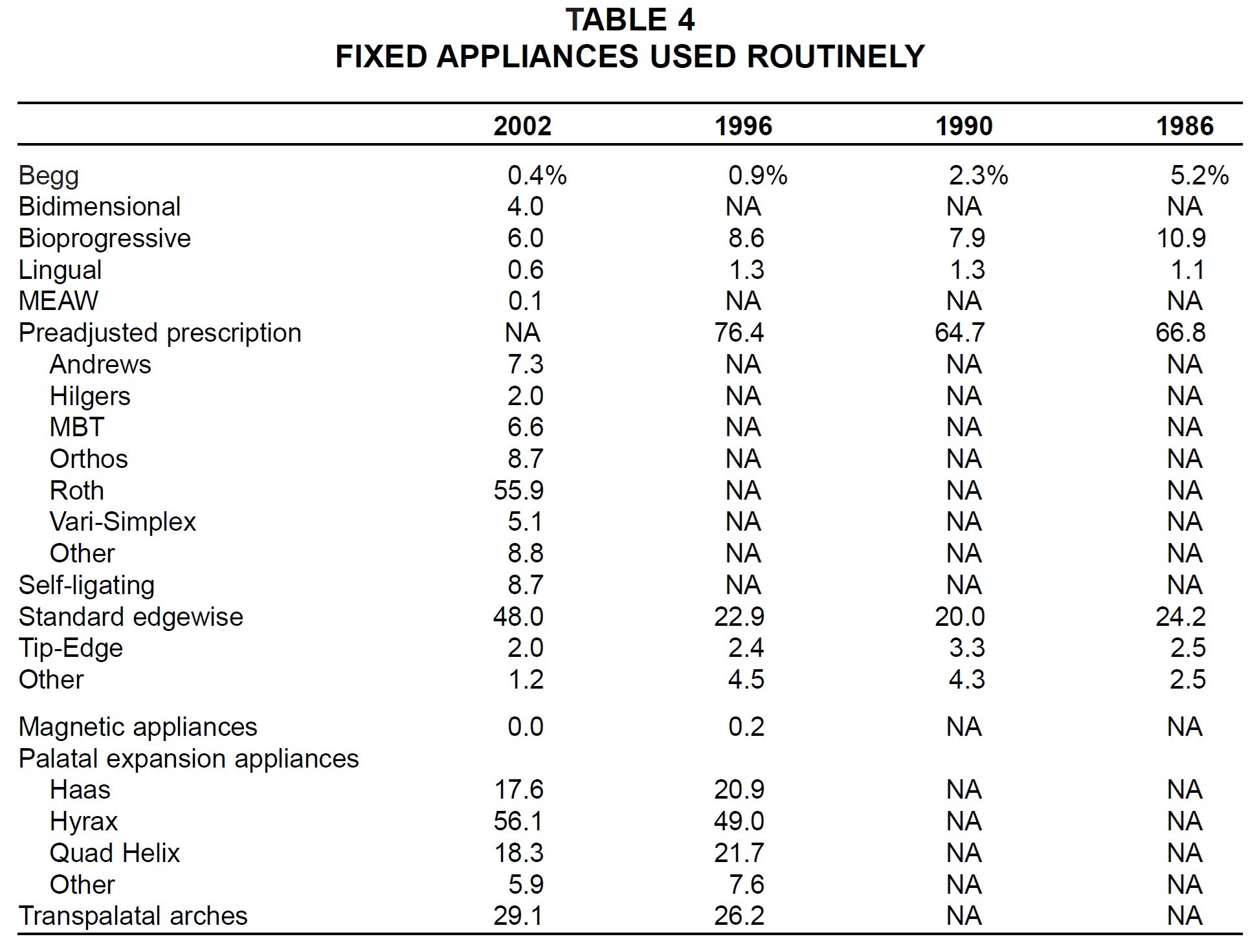
While almost all respondents continued to use stainless steel brackets, the mean number of patients with metal brackets dropped slightly between 1996 and 2002 (Table 5). More practices used ceramic, gold, and titanium brackets than in the last Study, but fewer used plastic and combination brackets. The .022" slot retained a slight edge over the .018" slot, and twin brackets were still much more popular than single brackets. Although miniaturized brackets were used in lower percentages of patients than in 1996, selfligating and "reduced friction" brackets were used more often. The vast majority of brackets continued to have mesh bases, but microetched and chemically enhanced bases were more common than in 1996. Recycling of brackets dropped off considerably over the past six years.
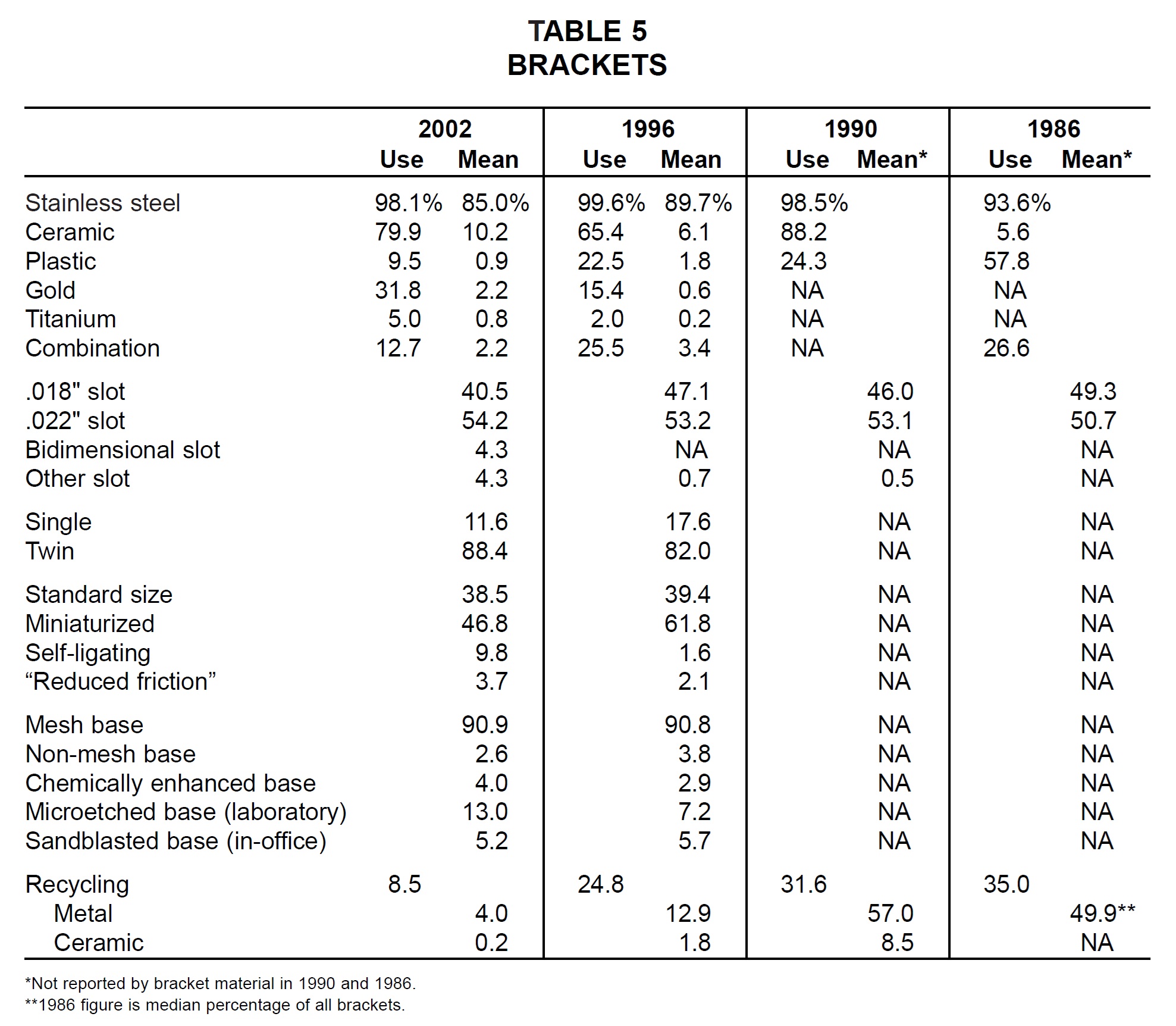
More than 90% of orthodontists continued to use direct bonding routinely, but somewhat higher percentages used indirect bonding and glass ionomers than in 1996 (Table 6). More than 20% routinely used the new self-etching primers, as the percentage who routinely etched with 37% phosphoric acid declined. The median bond failure rate remained at 5%, with by far the most failures on the mandibular posterior teeth. Two-paste adhesives were still slightly more popular than one-paste adhesives among the chemically cured bonding agents. Light curing was used routinely by more than three-quarters of the respondents to the 2002 Study--a substantial jump over the 1996 results. One-paste adhesives held a decided edge over precoated brackets and two-paste adhesives. The median curing time was 20 seconds per tooth, and intense visible light was used routinely by slightly more respondents than standard visible light.
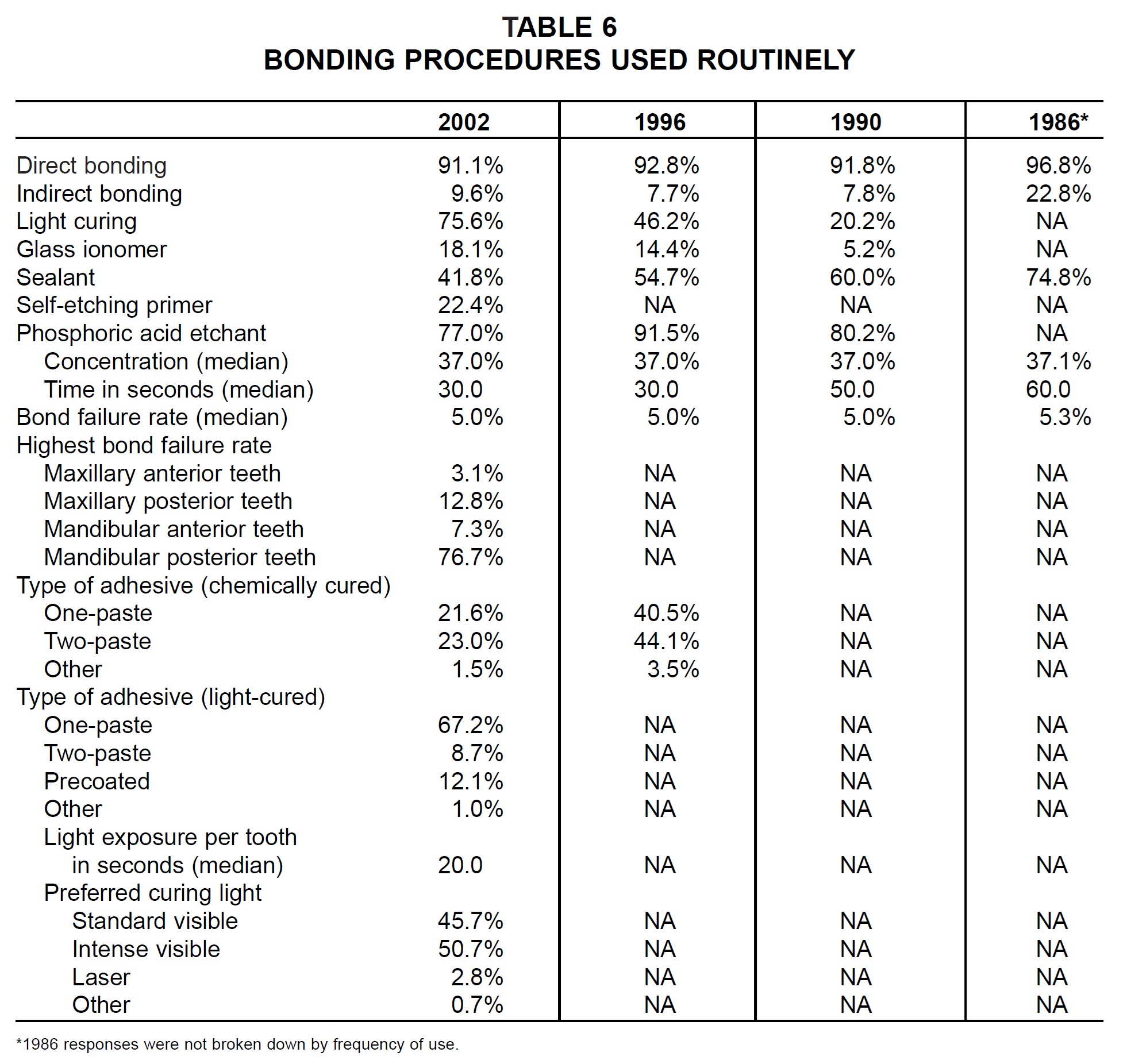
Compared to the 1996 Study, more respondents used light-cured glass ionomer band cements routinely, but fewer used standard glass ionomer band cements (Table 7). Compomers and zinc phosphates were used routinely by only a few clinicians.
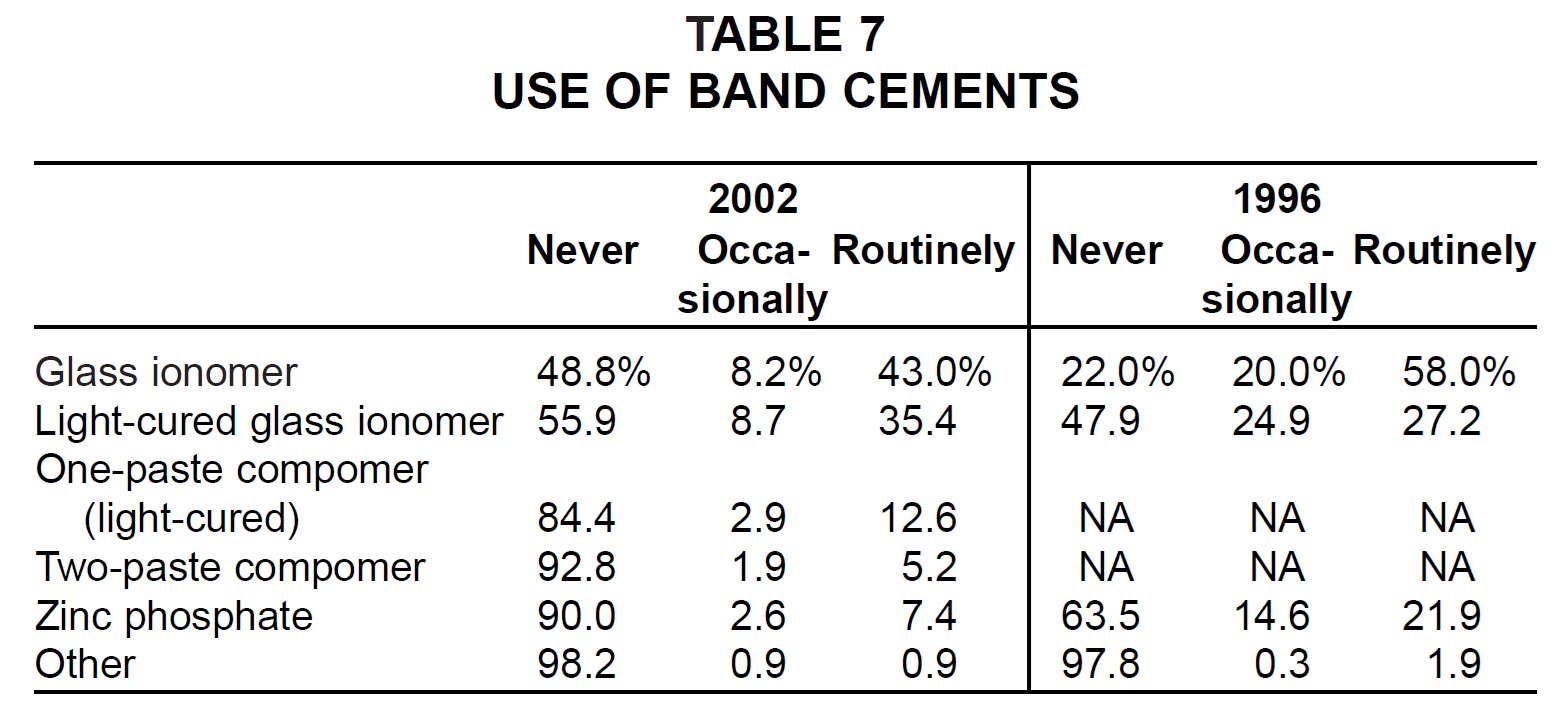
The only teeth that were routinely banded by a majority of orthodontists in 2002 were second molars, but all molars and premolars were banded less routinely than in the past (Table 8). Mandibular second molars were somewhat more likely to be bonded than other molars, but were still bonded routinely by less than one-third of the respondents.
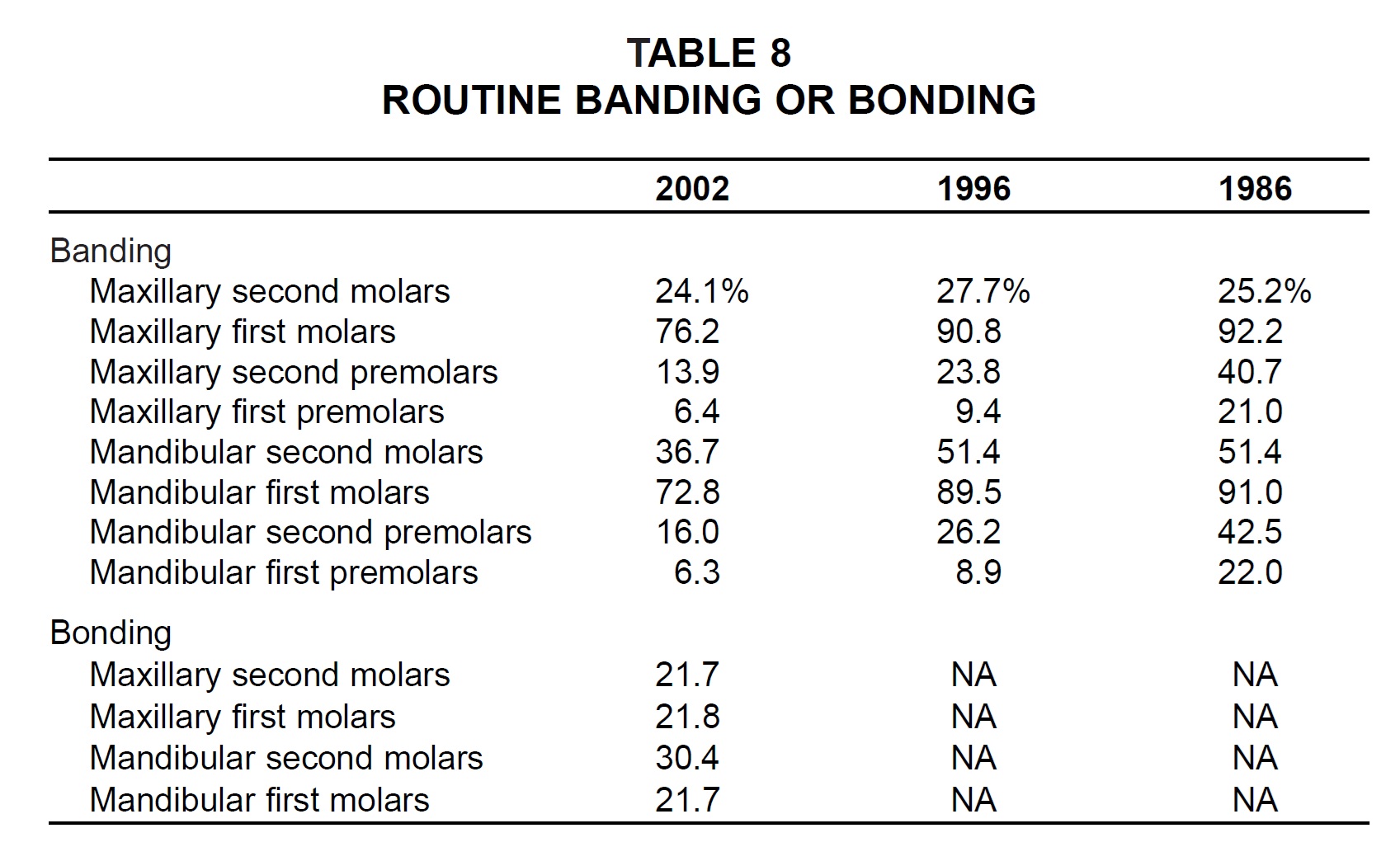
The current Study showed a marked increase in usage of titanium alloys for initial archwires, with stainless steel still used by most practitioners for finishing archwires (Table 9). The median number of archwires used in each arch was four in both extraction and nonextraction cases.
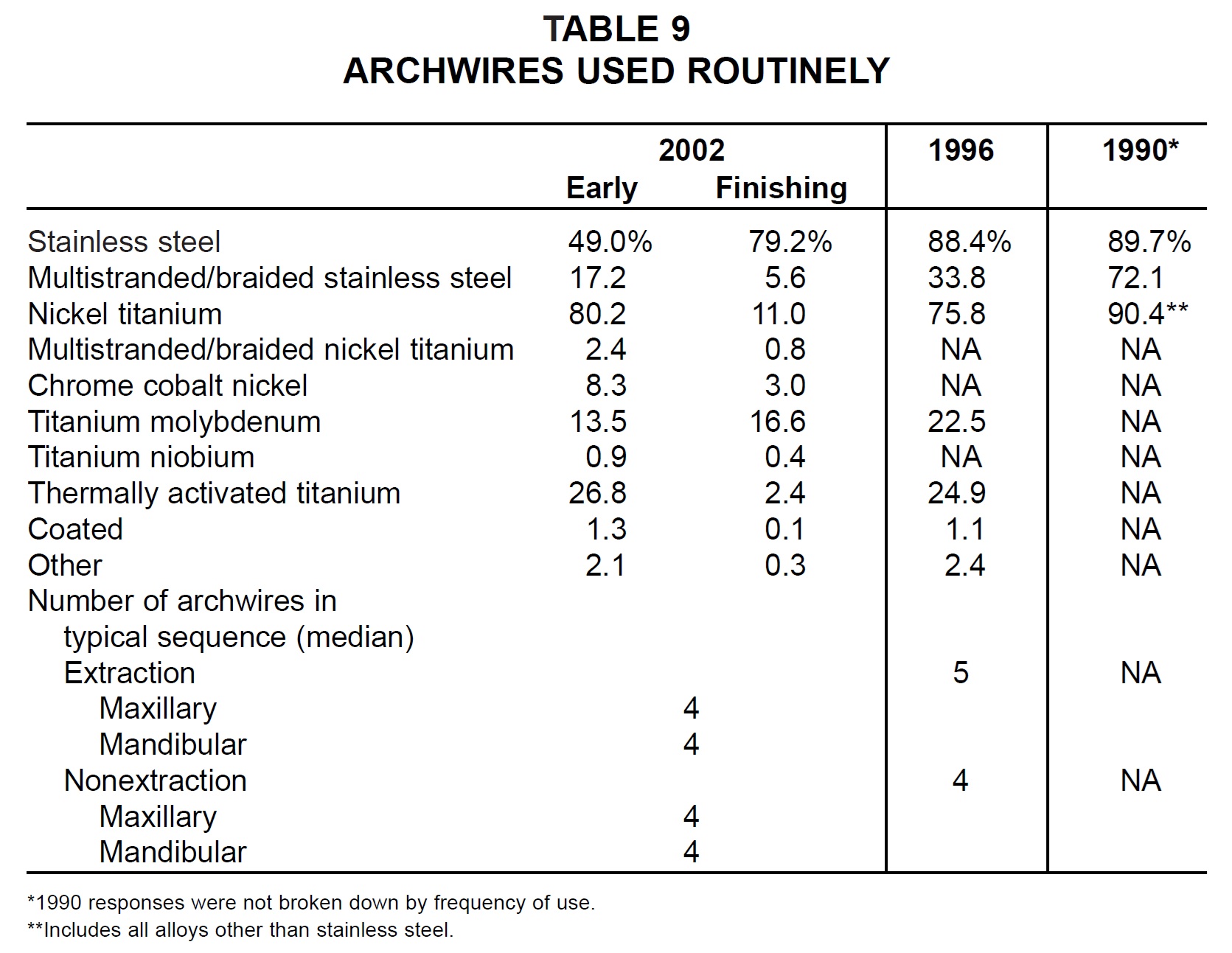
Other Appliances
The only removable and functional appliances used routinely by more orthodontists in 2002 than in past studies were the banded and crowned Herbst appliances and the Hilgers Pendulum (Table 10). Invisalign appliances were routinely prescribed by 11% of the respondents in the first appearance of this method on the questionnaire.
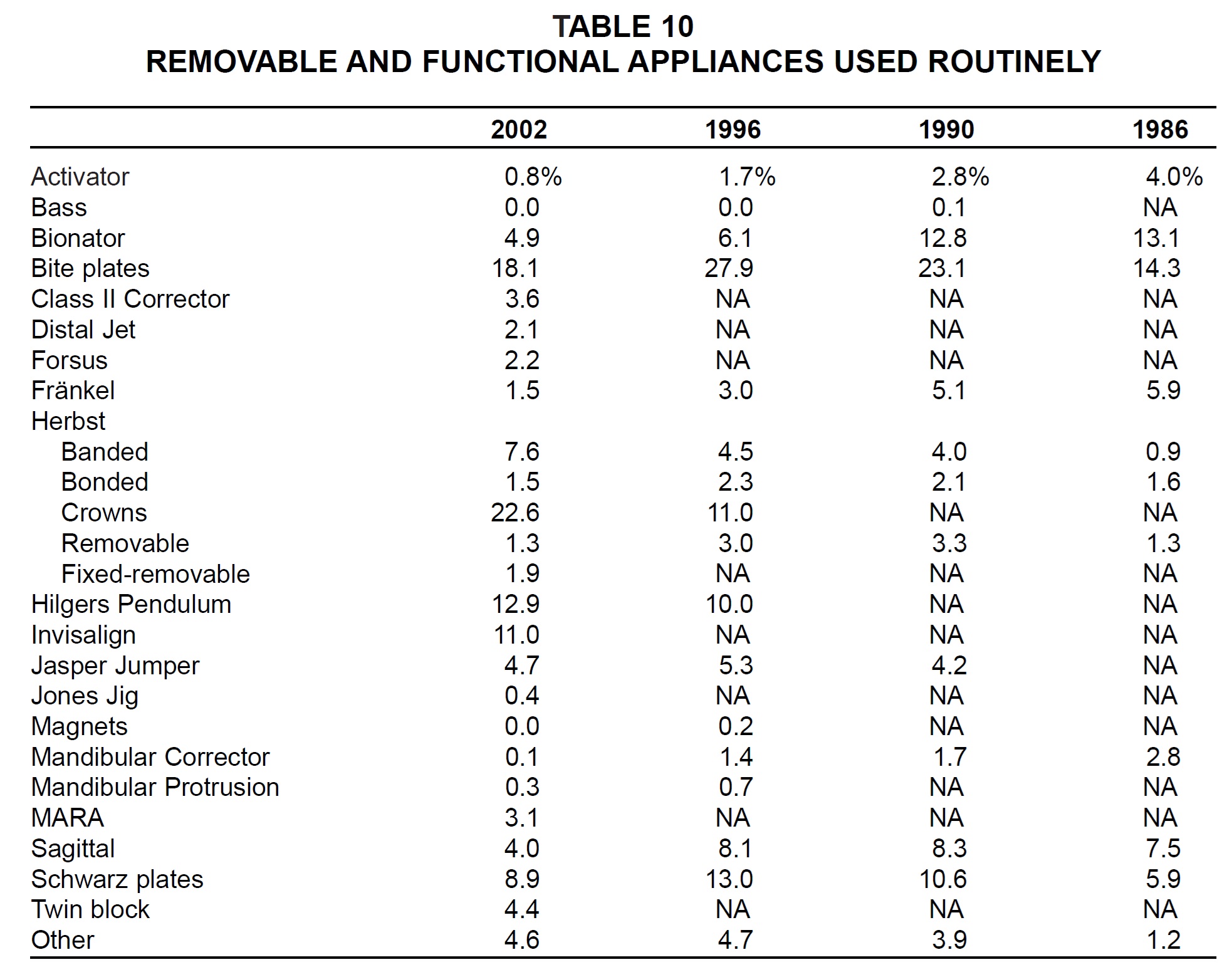
A trend toward outside laboratory rather than in-office fabrication of functional appliances continued (Table 11). The only appliances constructed in-house by a majority of respondents were bite plates, the Class II Corrector, the Forsus, the Jasper Jumper, and the Jones Jig (the latter three being prefabicated).
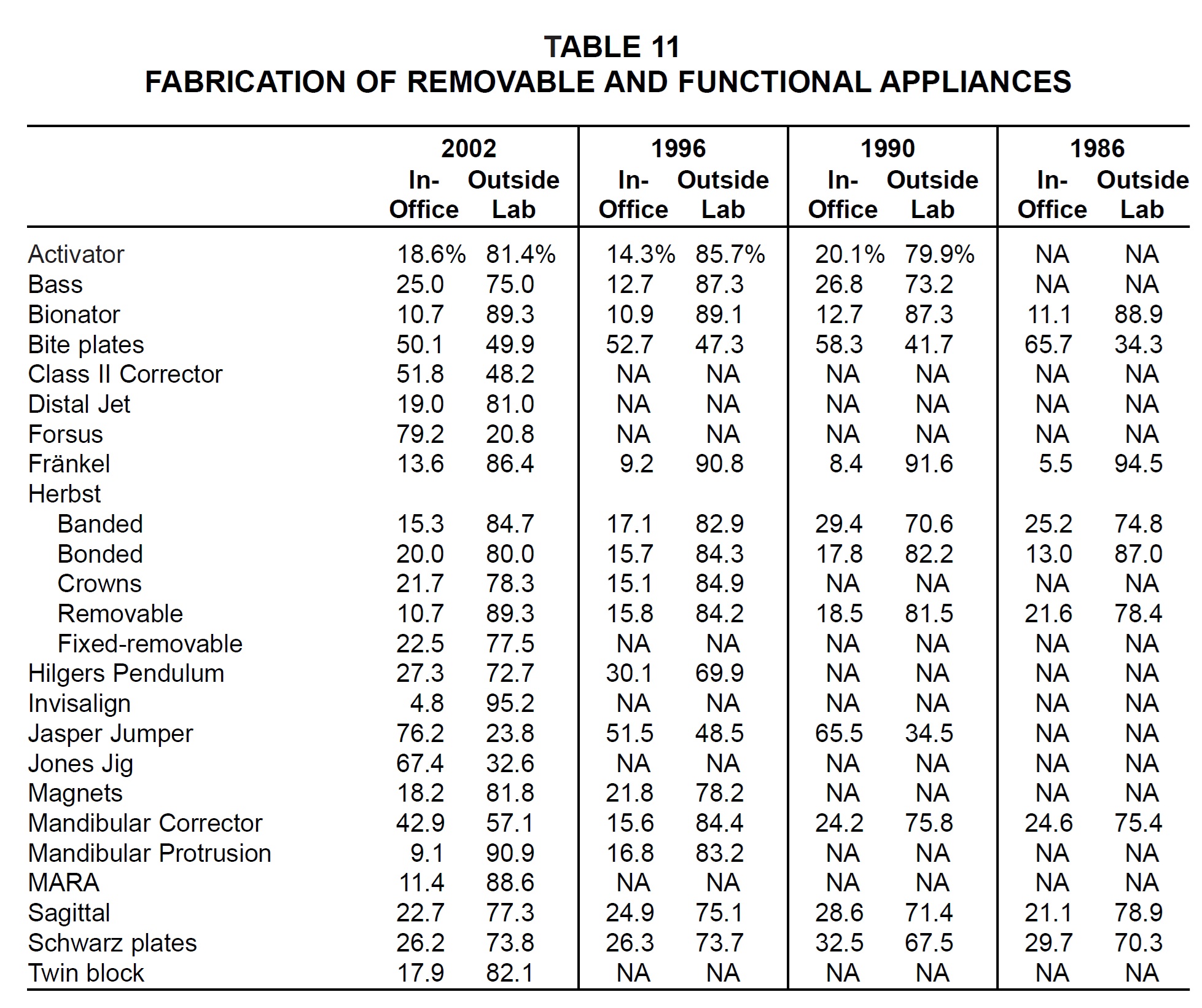
Routine use of headgear decreased markedly between 1996 and 2002 (Table 12). Only chin cups and facial masks were used routinely by higher percentages of clinicians than ever before, and those by fewer than 13% each.
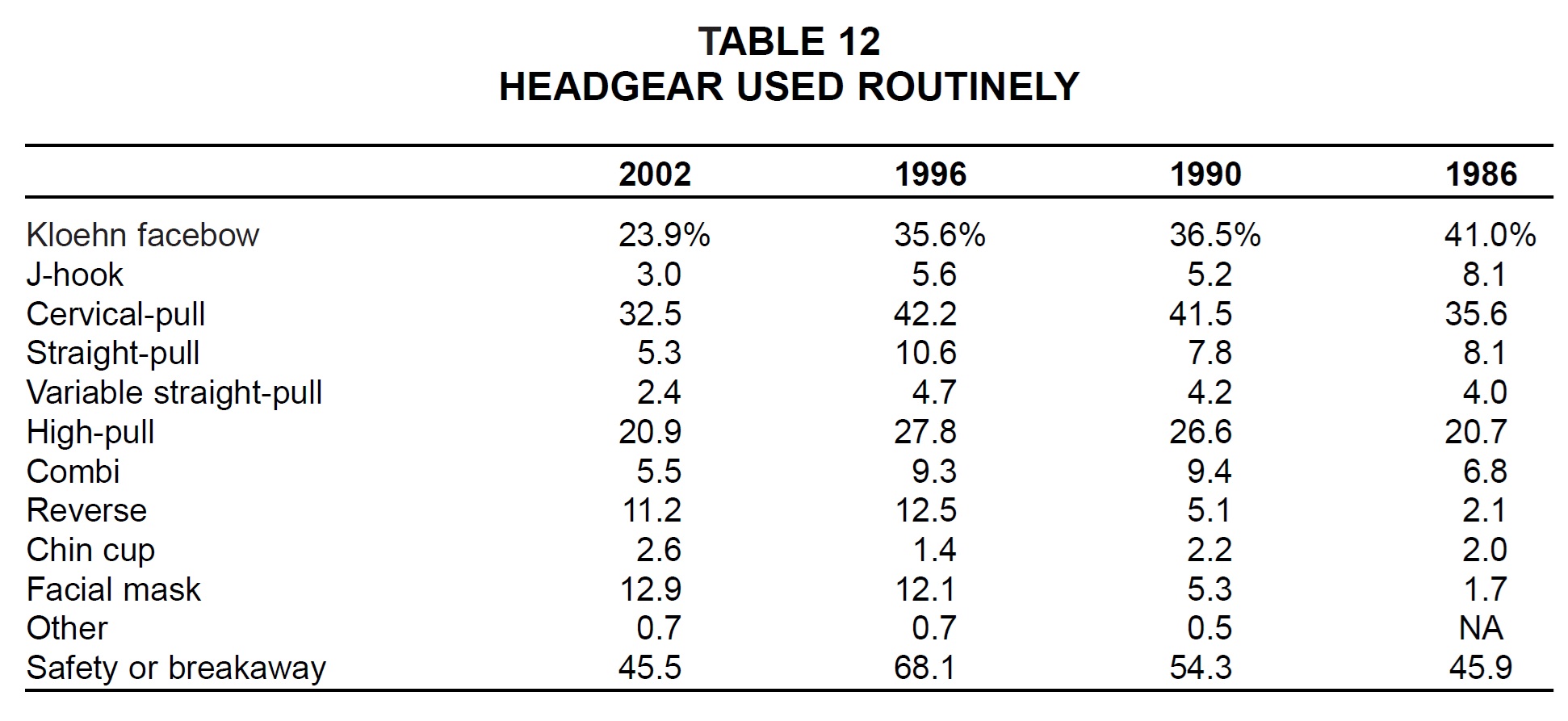
Extractions
Although almost all respondents continued to treat at least some cases with extractions, the median percentage of extraction cases reached an all-time low of 20% (Table 13). The most common extraction prescription remained four first premolars, followed by other combinations of first and second premolars.
Third molars represented a mean of only about 11% of all extractions, while about 19% of the respondents used third molar enucleation. Most orthodontists continued to prescribe serial extractions when needed, and more than onethird used sectional wires for initial cuspid retraction in extraction cases.
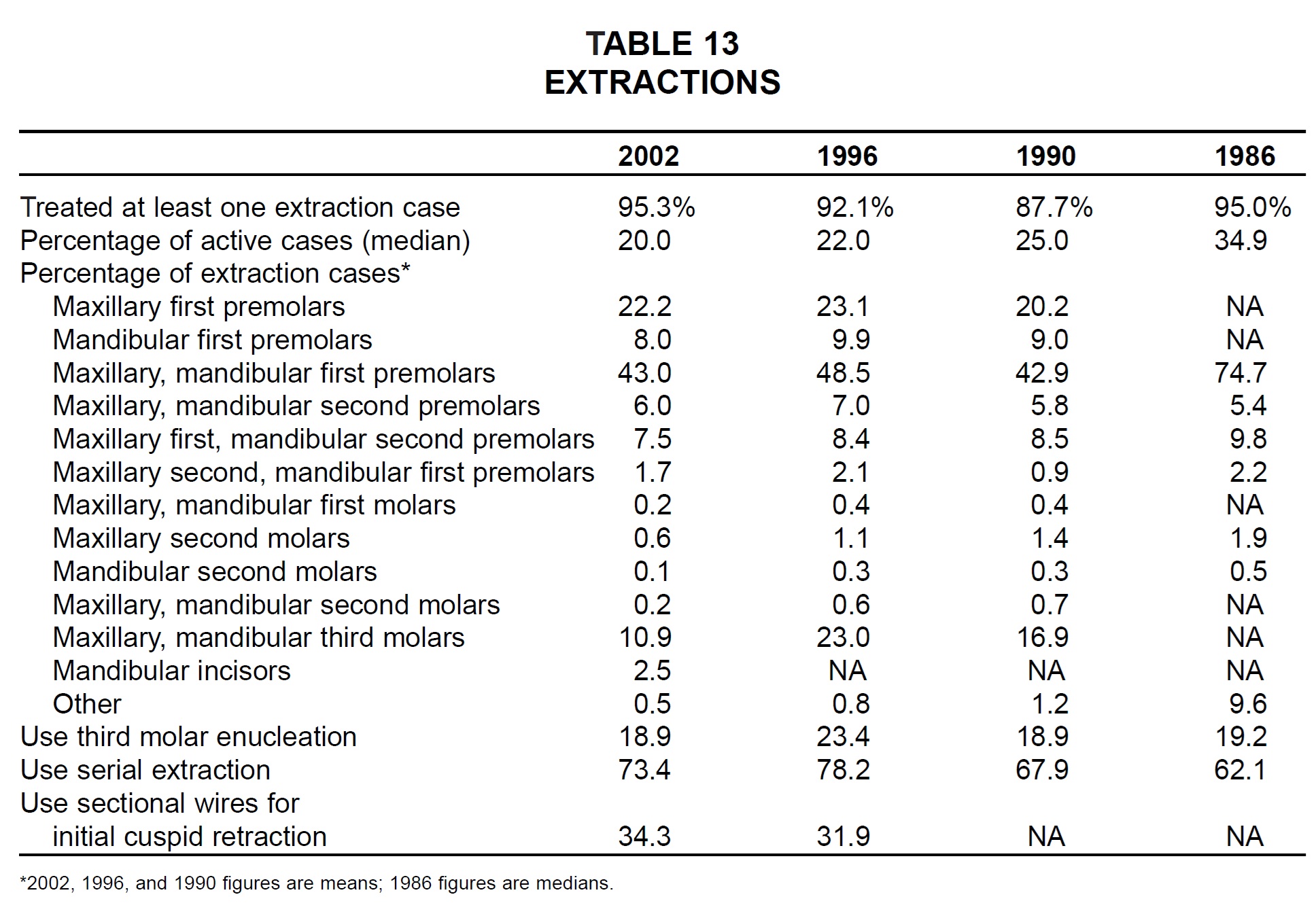
Finishing and Retention
The cosmetic finishing procedures surveyed continued to reflect an upward trend in routine use (Table 14). More than two-thirds of the respondents in 2002 routinely performed incisal adjustments and some method of anterior stripping. More than one-third routinely performed posterior stripping, and about one-fourth routinely used zig-zag elastics.
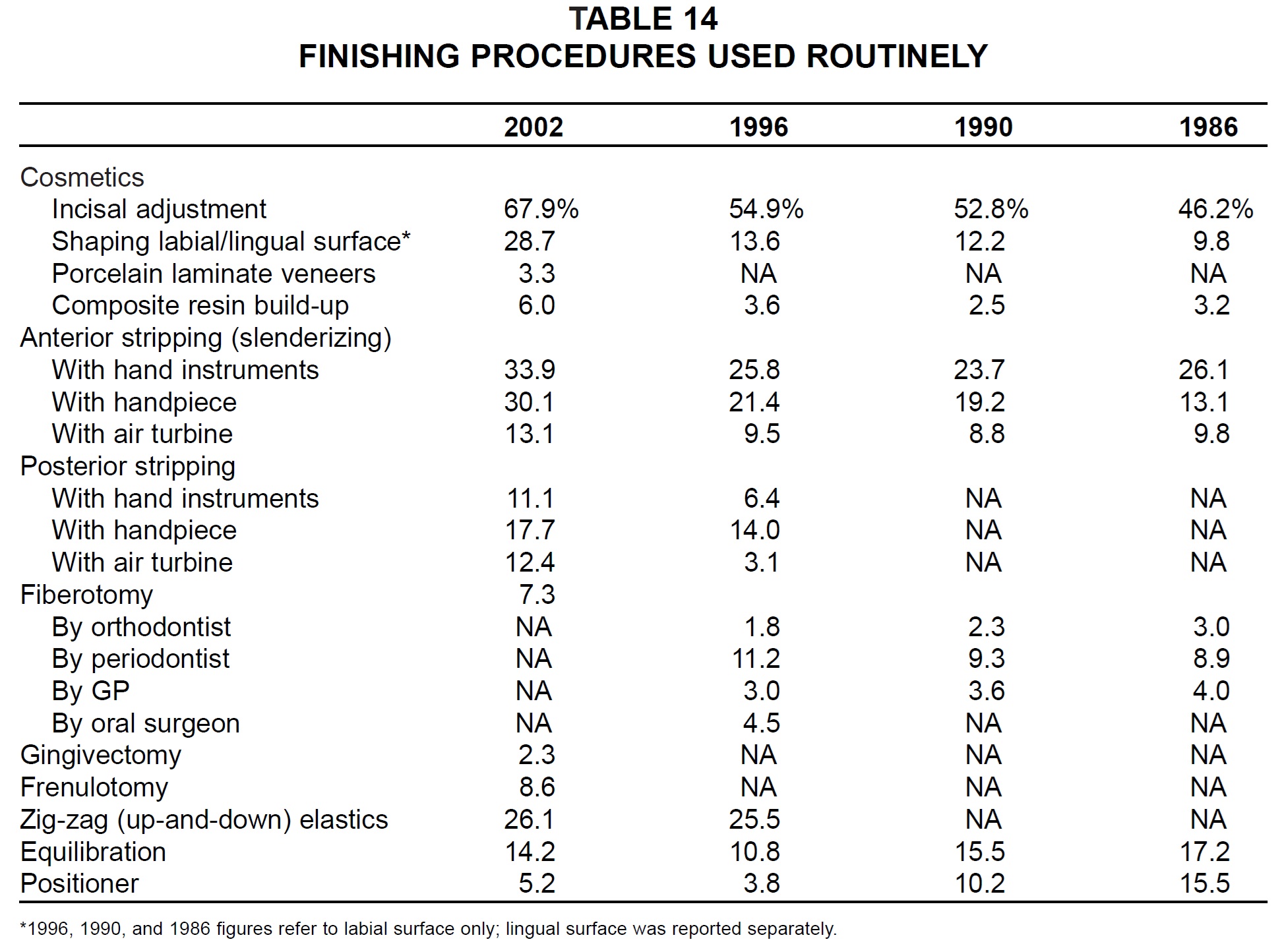
Although the Hawley retainer remained the most commonly used, "invisible" types of retainers continued to gain in popularity (Table 15). Fixed banded retainers continued to decline in routine usage, but fixed bonded retainers continued to increase, with nearly one-third of the clinicians using them routinely in the mandibular arch. Compared to the past two surveys, slightly fewer respondents specified a retention period (with a median of 24 months), and more respondents said they prescribed "permanent" retention.
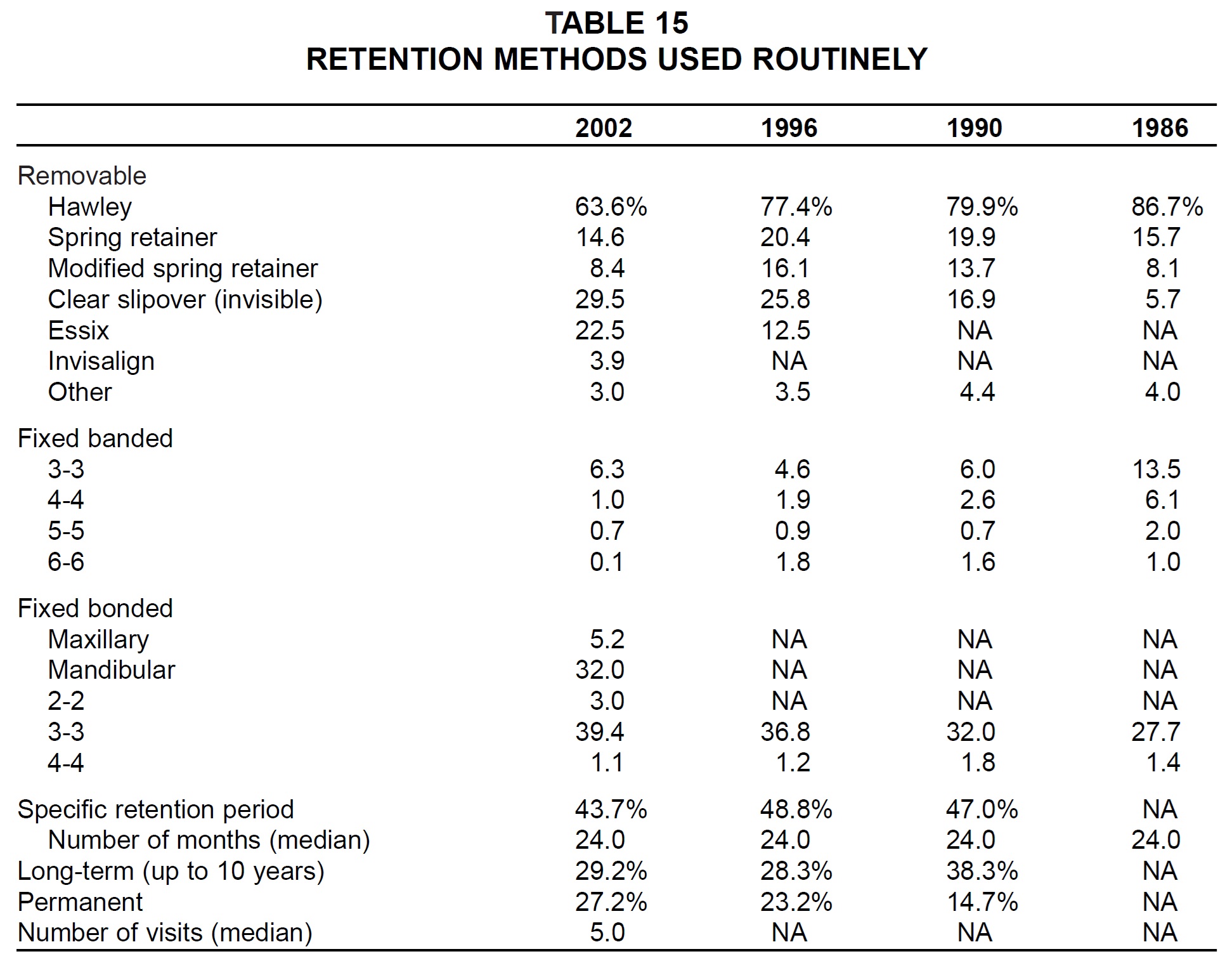
TMJ and Surgical-Orthodontic Treatment
As in the 1996 Study, more than 70% of the respondents reported treating at least one TMJ case in the preceding year, with a median of five patients and a median of 50% combined with orthodontic treatment (Table 16). With successful treatment defined as "asymptomatic one year post-treatment", the median success rate dropped from 80% to its 1990 level of 75%. Although the only diagnostic materials used more in 2002 than ever before were tomograms, nearly all the respondents still used health histories and muscle palpation, and a majority used mounted casts.
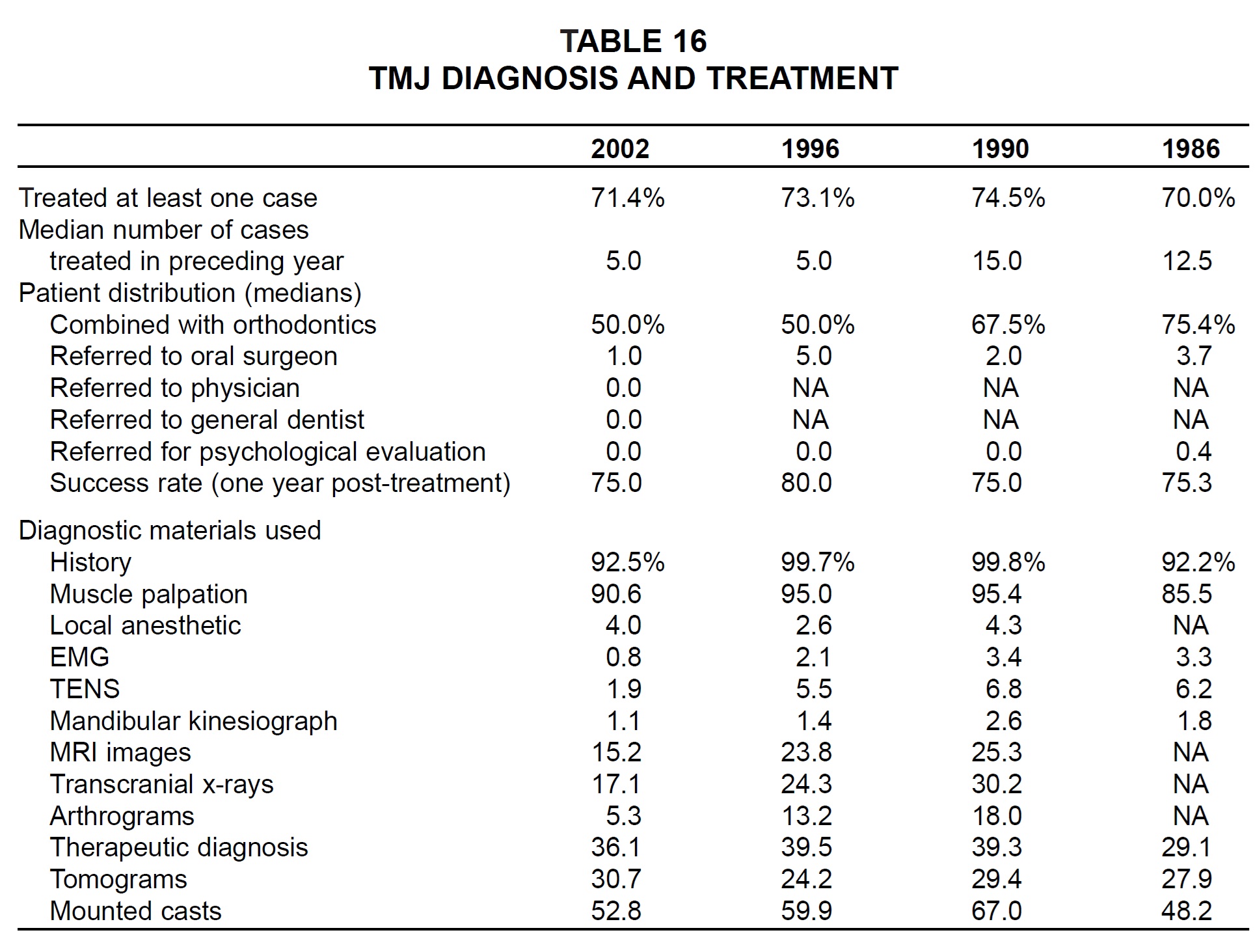
Most of the clinicians attributed TMJ dysfunction to a combination of causes, but the most significant was considered to be stress, followed by trauma and muscle dysfunction (Table 17). Occlusion, mutilated dentition, pathology, and anatomy were all rated somewhat significant.
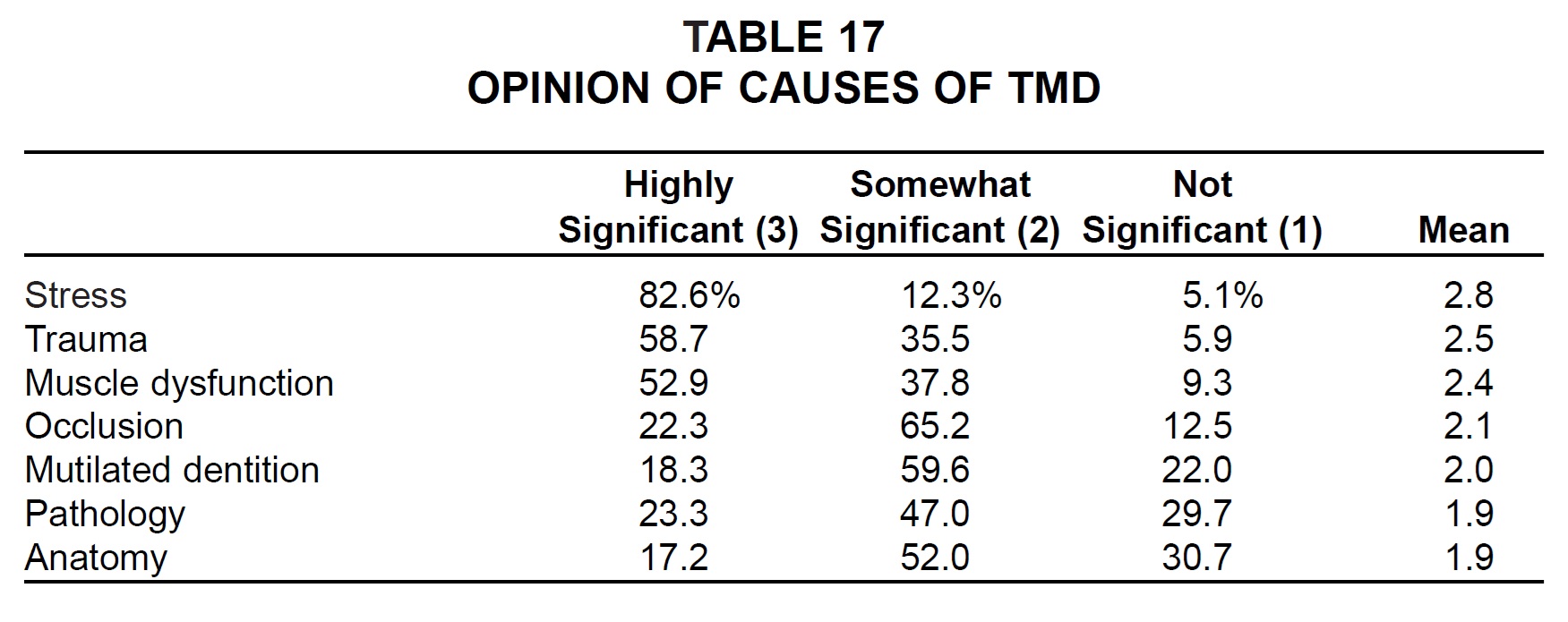
Splints remained the most routinely used TMJ treatment method, followed by nonsteroidal anti-inflammatory drugs and palliative therapy such as reassurance, heat, and cold (Table 18). Other methods used more routinely in 2002 than ever before, though still by small numbers of respondents, were myofunctional therapy, acupuncture, osteopathic manipulation, and orthognathic surgery.
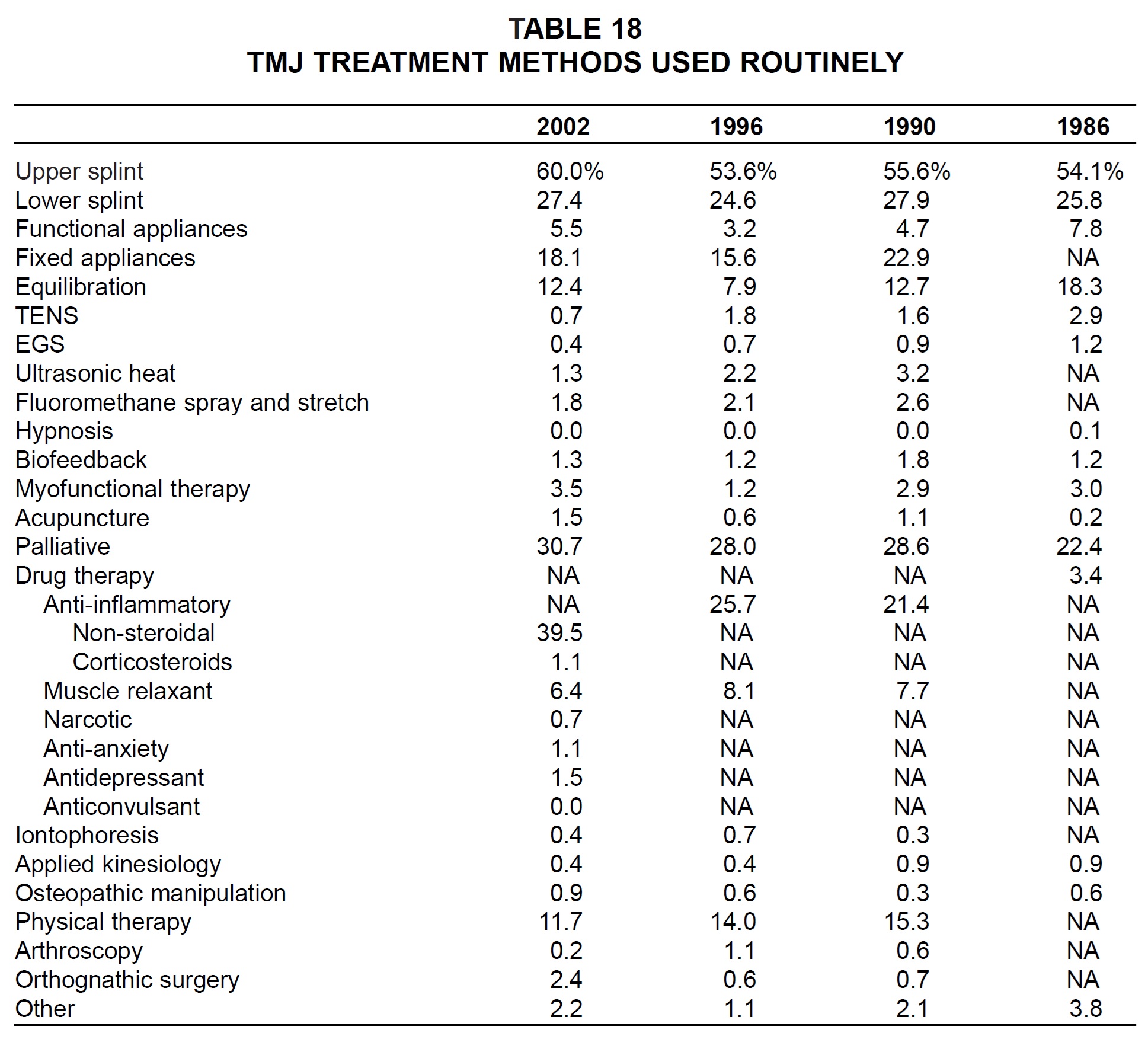
Nearly all orthodontists reported treating at least one surgical-orthodontic case in 2001, but the median number of cases remained at five (Table 19). A few more respondents said the majority of treatment-planning decisions were made by the orthodontist as opposed to a team. As in previous surveys, a median of 50% of the surgeries were mandibular and 25% involved both jaws; only 6% were maxillary, fewer than before. (These groups of figures do not add up to 100% because medians are reported instead of means.) The median percentage of Class II patients remained at 50%, while the percentage of Class III patients rose slightly to 30%. As in the past, the orthodontist was entirely satisfied with a median 80% of the results, and the patient was entirely satisfied a median 90% of the time.
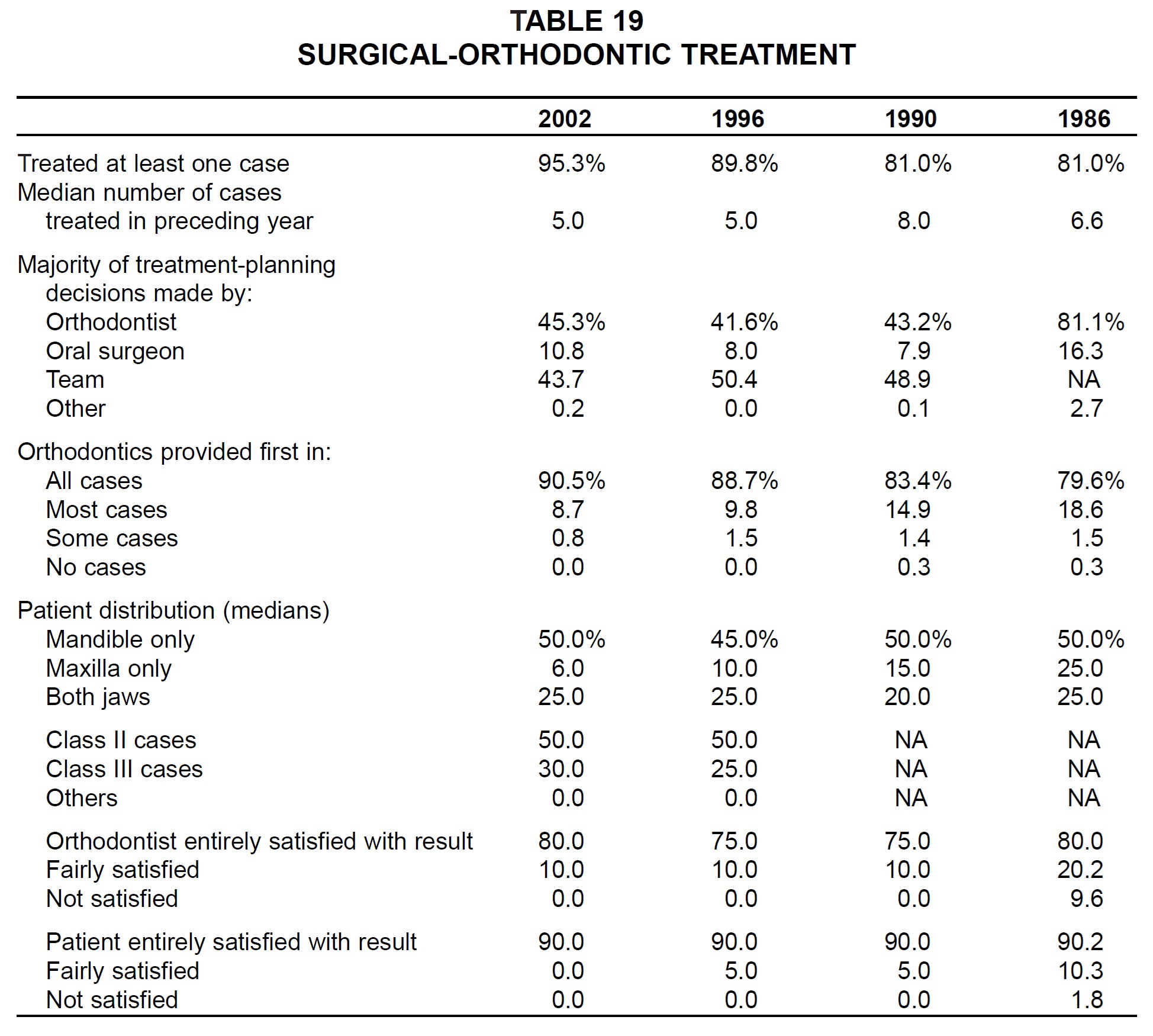
The appliances listed in this Study are trademarks of their respective companies: MBT and Forsus, 3M Unitek, 2724 S. Peck Road, Monrovia, CA 91016; Orthos, Vari-Simplex, Pendulum, and MARA, Ormco/"A" Company, 1717 W. Collins Ave., Orange, CA 92867; Tip-Edge, TP Orthodontics, Inc., 100 Center Plaza, La-Porte, IN 46350; Quad Helix and Elgiloy, RMO Inc., P.O. Box 17085, Denver, CO 80217; Distal Jet, Jasper Jumper, and Jones Jig, American Orthodontics, 1714 Cambridge Ave., Sheboygan, WI 53082; Invisalign, Align Technology, Inc., 851 Martin Ave., Santa Clara, CA 95050; Essix, Raintree Essix, Inc., 1069 S. Jeff Davis Parkway, New Orleans, LA 70125.
